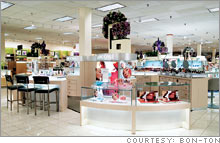It looks like bon temps for Bon-TonThe department-store chain looks like a smart buy right now, despite its third-quarter loss.(Fortune) -- At first glance the numbers for Bon-Ton, a regional department-store chain with a market cap of about $700 million, don't seem promising: same-store sales down 5.8% in December, a net loss of $0.66 a share in the third quarter and more than $1 billion in long-term debt. But do the homework, and Bon-Ton starts to look like this season's great buy. Founded in 1898, Bon-Ton (Charts) has built a collection of seven regionally branded department-store chains, including Bergner's, Younkers and Herberger's. Its multibrand strategy is a key point of differentiation from big chains like J.C. Penney (Charts), Kohl's (Charts) and Federated Department Stores (Charts), says CEO Bud Bergren: "Eighty-five percent of the product we carry is not carried in a Kohl's or a Penney's. We give the customer a reason to come to us."
The point of interest for investors though is last year's acquisition of 142 stores in Saks Inc (Charts).'s Northern Department Store Group, for $1.1 billion in cash. The deal, which doubled the company's size, was responsible for the company's third-quarter loss. But now that Bon-Ton has integrated the new stores, shareholders should see an increasing benefit from more than $30 million in cost savings that Bon-Ton expects as a result of consolidation of back-office functions. The deal will also boost the chain's performance. The acquired stores were superior to Bon-Ton's existing stores on a variety of measures, including the private-label business, merchandising mix and pricing. "Bon-Ton had gotten into the habit of being overly promotional and giving margin away," says Kristin Pak, sector manager for RS Funds. In addition, the acquisition gives the chain an injection of retailing talent: Bon-Ton has replaced many of its own managers with newcomers from the Saks group. Some key Bon-Ton numbers have already improved. In the third quarter, gross margins increased almost three percentage points to 37%. Sales have jumped. Pak expects that these trends will continue, with earnings per share hitting $3 in fiscal 2007, up from her estimate of $2.20 in 2006. Bon-Ton has used acquisition as a springboard for growth before. In 2003, it bought Elder-Beerman stores, which took the company from $700 million in sales in fiscal 2002 to more than $1.3 billion in 2004. While the stock has been on a tear, it still trades at only about 14 times estimated 2007 earnings, making this an opportune time to shop for shares. |
Sponsors
|

